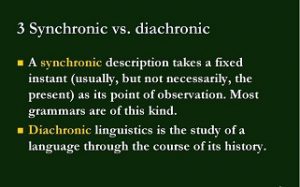synchronic and diachronic linguistics are distinct but complementary concepts used in linguistics to indicate different perspectives on language study: the study of language at a specific time (synchrony) and the study of language over time (diachrony).

These two concepts were initially approached by the linguist Ferdinand de Saussure, who argued that language could and should be studied as an autonomous reality at a given point in time, without the need to analyze its evolutionary processes. He claimed that the only linguistic reality known to the speaker was the currently functioning language.
A complete and effective study of the language would have to contemplate these two aspects, focusing both on the changes that occurred in the language and on the functioning of the language at a given moment.
synchrony linguistics
A synchronic study of language focuses on the characteristics that the language presents during a given period of time. So:
- it is momentary, not being studied the evolution of the language in time, but only a specific moment inserted in this evolutionary process;
- presents static and descriptive characteristics, referring to the state of the language at that specific moment;
- studies only the language variations that coexist at a given time, such as regional, social and situational variations;
- analyzes the language as a closed set that presents regularity and homogeneity typical of a given time.
diachrony linguistics
A diachronic study of language focuses on the changes that language presents over time. So:
- presents the evolution that words undergo through time, analyzing the transformations that have taken place until the current word;
- it has dynamic and historical characteristics, going back to the origin of words;
- by focusing on the evolutionary process of the language, it is characterized as the study of the succession of different diachronies, enabling comparisons.
What is the difference between synchronic and diachronic linguistics?
Synchronic linguistics is the study of language at a given time, while diachronic linguistics is the study of language across different periods of history. Thus, the main difference between synchronic and diachronic linguistics is their focus or point of view of study. Diachronic linguistics is concerned with the evolution of language, while synchronic linguistics is not. Additionally, the latter focuses on subjects such as comparative linguistics, etymology, and language evolution, while the former focuses on grammar, classification, and organization of the features of a language.